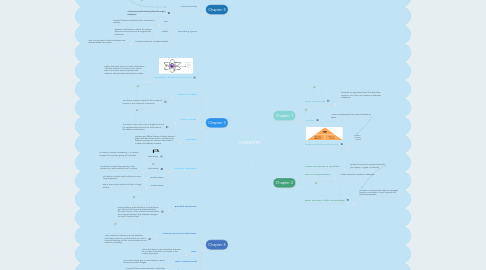
1. Chapter 3
1.1. Evolution of atomic structure
1.1.1. Dalton described atom as a hard, solid sphere. After two centuries it became clear that an atom has nucleus made of protons and neutrons, with electrons orbiting the nucleus.
1.2. Atomic number
1.2.1. The atomic number is equal to the number of protons in the nucleus of an element.
1.3. Atomic mass
1.3.1. The atomic mass is the mass of single atom and it is approximately equal to the total mass of the neutrons and protons.
1.4. Isotopes
1.4.1. Isotopes are different forms of single element : atoms with the same number of protons, but different numbers of neutrons.Same atomic number, but different massess.
1.5. Nuclear reactions
1.5.1. Beta Decay
1.5.1.1. The atomic number increases by 1, a neutron changes into a proton giving off a electron.
1.5.2. Alpha Decay
1.5.2.1. The atomic number decreases by 2, the release of an alpha particle from a nucleus.
1.5.3. Nuclear Fission
1.5.3.1. The atomic nucleus is split into two or more large fragments.
1.5.4. Nuclear Fusion
1.5.4.1. Two or more nuclei combine to form a larger nucleus.
2. Chapter 4
2.1. Excited electrons
2.1.1. During heating, some electrons of metal atoms get "excited" and move to distances farther from the nucleus. When electrons move back to their original distance, they released energy in the form of colored light.
2.2. Valence and core electrons
2.2.1. Atom consists of valence and core electrons. The valence electrons are those that are used in chemical bonding and the core electrons are not involved in bonding.
2.3. Ions
2.3.1. Atoms that loses or gains electrons, because the number of electrons isn't equal to the number of protons.
2.4. Ionic compounds
2.4.1. Form when atoms gain or lose electrons, atoms become ions with charges.
2.5. Polyatomic icons
2.5.1. Consist of two or more elements. Atoms stay together all the time.
2.6. Electron configuration
2.6.1. It is shorthand notation to keep track of the electrons in an atom.
3. Chapter 5
3.1. Solubility
3.1.1. Substances that dissolve in water are soluble in water and substances that do not dissolve are insoluble in water.
3.2. Conductivity
3.2.1. It shows how well electricity flows through a substance.
3.3. Bonding types
3.3.1. Ionic
3.3.1.1. Result of transfer of electrons from one atom to another.
3.3.2. Metallic
3.3.2.1. Between metal atoms in which the valence electrons are free to move throughout the substence.
3.3.3. Covalent molecular, Covalent network
3.3.3.1. One or more pairs of valence electrons are shared between the atoms.
4. Chapter 1
4.1. Tools and safety
4.1.1. Chemists use specialized tools that help them measure, mix, heat, cool, observe or separate substances
4.2. Matter
4.2.1. Matter is anything that has mass and takes up space.
4.3. Mass, volume, and density
4.3.1. m=D*V D=m/V V=D/m
5. Chapter 2
5.1. Chemical names & symbols
5.1.1. Symbols are used to represent elements. (Cu-copper, Au-gold, Cl-chlorine).
5.2. Law of conservation
5.2.1. Matter cannot be created or destroyed.
5.3. Basic periodic table knowledge
5.3.1. Elements on the periodic table are arranged based on similarities in their chemical and physical properties.

